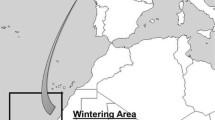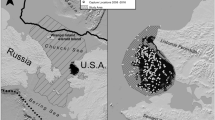Abstract
Estimating the effects of environmental factors on the population dynamics of albatrosses is necessary for their conservation. This requires estimation of demographic parameters, long-time series of capture–recapture data, and knowledge of their at-sea distribution. For biennial albatrosses, multistate mark–recapture models (MSMR) considering individuals during their sabbatical year as unobservable could provide reliable estimates. However, this requires that state assignment is determined with certainty which may not be the case in historical data. We applied multievent mark–recapture models (MEMR) to data on adult Wandering Albatross (Diomedea exulans) at Possession Island collected between 1966 and 2006. The models accounted for state uncertainty for those breeding states where the breeding outcome was uncertain. Survival estimates obtained from models not accounting for temporary emigration were higher than those obtained from models accounting for temporary emigration. For males and females, survival estimates from the MEMR models were higher than those from CJS and MSMR models. Annual survival probability was 0.924 (SE = 0.034) for breeding females, 0.971 (SE = 0.038) for non-breeding females, 0.954 (SE = 0.018) for breeding males, and 0.938 (SE = 0.017) for non-breeding males. Whereas Wandering Albatrosses are generally considered as obligate biennial breeders, we found that the probability that successful breeders attempted to breed in a subsequent year was 0.069 for females and 0.048 for males, although their probability of success was 44–62% lower than that of individuals that skipped breeding.

Similar content being viewed by others
References
Bennett PM, Owens IPF (2002) Evolutionary ecology of birds. Oxford University Press, Oxford
Brothers N (1991) Albatross mortality and associated bait loss in the Japanese longline fishery in the Southern Ocean. Biol Conserv 55:255–268
Brownie C, Hines JE, Nichols JD, Pollock KH, Hestbeck JB (1993) Capture-recapture studies for multiple strata including non-Markovian transition probabilities. Biometrics 49:1173–1187
Burnham KP, Anderson DR (1979) The composite-dynamic method as evidence for age-specific waterfowl mortality. J Wildl Manag 43:356–366
Burnham KP, Anderson DR (2002) Model selection and multimodel inference: a practical information-theoretic approach. Springer, New York
Choquet R, Reboulet A-M, Pradel R, Gimenez O, Lebreton J-D (2006) M-SURGE 1.8 user’s manual. CEFE, Montpellier
Choquet R, Rouan L, Pradel R (2009a) Program E-SURGE: a software application for fitting multievent models. In: Thomson DL, Cooch EG, Conroy MJ (eds) Modeling demographic processes in marked populations. Springer, New York, pp 845–865
Choquet R, Lebreton J-D, Gimenez O, Reboulet A-M, Pradel R (2009b) U-CARE: Utilities for performing goodness of fit tests and manipulating capture-recapture data. Ecography 32:1071–1074
Cole DJ, Morgan BJT (2011) Determining parameter redundancy of multistate mark-recapture models for seabirds. J Ornithol (in press)
Conn PB, Cooch EG (2009) Multistate capture-recapture analysis under imperfect state observation: an application to disease models. J Appl Ecol 46:486–492
Converse SJ, Kendall WL, Doherty PF Jr, Ryan PG, Johnson DH (2009) Multistate models for estimation of survival and reproduction in the grey-headed albatross (Thalassarche chrysostoma). Auk 126:77–88
Delord K, Besson D, Barbraud C, Weimerskirch H (2008) Population trends in a community of large Procellariiforms of Indian Ocean: potential effects of environment and fisheries interactions. Biol Conserv 141:1840–1856
Fujiwara M, Caswell H (2002) A general approach to temporary emigration in mark-recapture analysis. Ecology 83:3266–3275
Gales R (1998) Albatross populations: status and threats. In: Robertson G, Gales R (eds) Albatross biology and conservation. Surrey Beatty, Chipping Norton, pp 20–45
Gauthier G, Millot E, Weimerskirch H (2011) Estimating dispersal, recruitment and survival in a biennal species, the wandering albatross. J Ornithol (in press)
Grosbois V, Gimenez O, Gaillard J-M, Pradel R, Barbraud C, Clobert J, Møller AP, Weimerskirch H (2008) Assessing the impact of climate variation on survival in vertebrate populations. Biol Rev 83:357–399
Hines JE, Sauer JR (1989) Program CONTRAST—a general program for the analysis of several survival or recovery rate estimates. Fish Wild Tech Rep 24:1–7
Hunter CM, Caswell H (2009) Rank and redundancy of multistate mark-recapture models for seabird populations with unobservable states. In: Thomson DL, Cooch EG, Conroy MJ (eds) Modeling demographic processes in marked populations. Springer, New York, pp 797–825
IUCN (2009) 2009 IUCN Red List of threatened species. http://www.iucnredlist.org/
Jouventin P, Weimerskirch H (1990) Satellite tracking of wandering albatrosses. Nature 343:478–746
Jouventin P, Lequette B, Dobson FS (1999) Age-related mate choice in the wandering albatross. Anim Behav 57:1099–1106
Kendall WL (2009) One size does not fit all: adapting mark-recapture and occupancy models for state uncertainty. In: Thomson DL, Cooch EG, Conroy MJ (eds) Modeling demographic processes in marked populations. Springer, New York, pp 765–780
Kendall WL, Bjorkland R (2001) Using open robust design models to estimate temporary emigration from capture-recapture data. Biometrics 57:1113–1122
Kendall WL, Nichols JD (2002) Estimating state-transition probabilities for unobservable states using capture-recapture/resighting data. Ecology 83:3276–3284
Kendall WL, Nichols JD, Hines JE (1997) Estimating temporary emigration using capture-recapture data with Pollock’s robust design. Ecology 78:563–578
Lebreton JD (2005) Dynamical and statistical models for exploited populations. Aust NZ J Stat 47:49–63
Nichols JD, Kendall WL, Hines JE, Spendelow JA (2004) Estimation of sex-specific survival from capture-recapture data when sex is not always known. Ecology 85:3192–3201
Phillips RA, Silk JRD, Croxall JP, Afanasyev V, Briggs DR (2004) Accuracy of geolocation estimates for flying seabirds. Mar Ecol Prog Ser 266:265–272
Pradel R (2005) Multievent: an extension of multistate capture-recapture models to uncertain states. Biometrics 61:442–447
Prince P, Rothery P, Croxall J, Wood A (1994) Population dynamics of black-browed and grey-headed albatrosses Diomedea melanophris and D. chrysostoma at Bird Island, South Georgia. Ibis 136:50–71
Rivalan P, Prévot-Juillard AC, Choquet R, Pradel R, Jacquemin B, Girondot M (2005) Trade-off between current reproductive effort and delay to next reproduction in the leatherback sea turtle. Oecologia 145:564–574
Rolland V, Nevoux M, Barbraud C, Weimerskirch H (2009) Respective impact of climate and fisheries on the growth of an albatross population. Ecol Appl 19:1336–1346
Rouan L, Choquet R, Pradel R (2009) A general framework for modelling memory in capture-recapture data. J Agric Biol Environ Stat 14:338–355
Ryan P, Phillips R, Nel D, Wood AG (2007) Breeding frequency in grey-headed albatrosses (Thalassarche chrysostoma). Ibis 149:45–52
Schaub M, Gimenez O, Schmidt BR, Pradel R (2004) Estimating survival and temporary emigration in the multistate capture-recapture framework. Ecology 85:2107–2113
Schwarz CJ, Schweigert JF, Arnason AN (1993) Estimating migration rates using tag-recovery data. Biometrics 49:177–193
Seber GAF (1982) The estimation of animal abundance and related parameters. MacMillan, New York
Tickell WLN (1968) The biology of the great albatrosses Diomedea exulans and Diomedea epomophora. Antarct Res Ser 12:1–55
Véran S, Gimenez O, Flint E, Kendall WL, Doherty PF Jr, Lebreton JD (2007) Quantifying the impact of longline fisheries on adult survival in the black-footed albatross. J Appl Ecol 44:942–952
Viallefont A, Cooke F, Lebreton JD (1995) Age-specific cost of first-time breeding. Auk 112:67–76
Vincent ZD (2008) Survival and reproduction in a biennially-breeding seabird, the Wandering Albatross. Master thesis, University of Cape Town
Waugh SM, Sagar PM, Paull D (1997) Laying dates, breeding success and annual breeding of southern royal albatrosses Diomedea epomophora epomophora at Campbell Island during 1964–69. Emu 97:194–199
Waugh S, Weimerskirch H, Moore P, Sagar P (1999) Population dynamics of black-browed and grey-headed albatrosses Diomedea melanophrys and D. chrysostoma at Campbell Island, New Zealand, 1942–96. Ibis 141:216–225
Weimerskirch H (1992) Reproductive effort in long-lived birds: age-specific patterns of condition, reproduction and survival in the wandering albatross. Oikos 64:464–473
Weimerskirch H, Wilson RP (2000) Oceanic respite for wandering albatrosses. Nature 406:955–956
Weimerskirch H, Brothers N, Jouventin P (1997a) Population dynamics of wandering albatross Diomedea exulans and Amsterdam albatross D. amsterdamensis in the Indian Ocean and their relationship with long-line fisheries: conservation implications. Biol Conserv 79:257–270
Weimerskirch H, Cherel Y, Cuénot-Chaillet F, Ridoux V (1997b) Alternative foraging strategies and resource allocation by male and female wandering albatrosses. Ecology 78:2051–2063
Weimerskirch H, Barbraud C, Lys P (2000) Sex differences in parental investment and chick growth in wandering albatrosses: fitness consequences. Ecology 81:309–318
Weimerskirch H, Bonadonna F, Bailleul F, Mabille G, Dell’Omo G, Lipp HP (2002) GPS tracking of foraging albatrosses. Science 295:1259
White GC, Burnham KP (1999) Program MARK: survival estimation from populations of marked animals. Bird Study 46:120–139
Acknowledgments
The present research project No 109 has been performed at Possession Island, Crozet Island, and was supported by the French Polar Institute (IPEV) and Terres Australes et Antarctiques Françaises. We thank all the field workers involved in the demographic study on Possession Island, and Dominique Besson and Karine Delord for data managing. The methods described (modelling survival in biennial species) were used following those developed by the Woods Hole Oceanographic Institution Albatross Demography Workshops, funded by NSF Grant DEB-0343820 and led by Hal Caswell and Christine Hunter. Discussions with Rémi Choquet, Roger Pradel and Stéphanie Jenouvrier were particularly helpful. We thank Bill Kendall and an anonymous referee for constructive comments on a previous version of the manuscript.
Author information
Authors and Affiliations
Corresponding author
Additional information
Communicated by W. L. Kendall.
Rights and permissions
About this article
Cite this article
Barbraud, C., Weimerskirch, H. Estimating survival and reproduction in a quasi-biennially breeding seabird with uncertain and unobservable states. J Ornithol 152 (Suppl 2), 605–615 (2012). https://doi.org/10.1007/s10336-011-0686-1
Received:
Revised:
Accepted:
Published:
Issue Date:
DOI: https://doi.org/10.1007/s10336-011-0686-1




